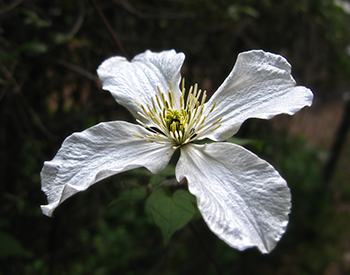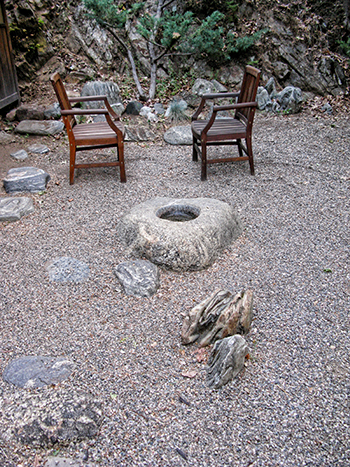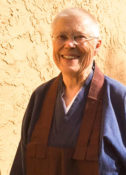The title of my retreat at Tassajara is “Finding Stillness Amid the Storm of Legal Practice.” This notion of stillness is central to a useful law practice, I believe. It is not a static or sort of dead stillness. It is instead alert and willing and ready, yet balanced and grounded. Implicit here is a great freedom that arises from nonattachment.
I am reminded of the wonderful lines by T.S. Eliot in “Burnt Norton,” the first of the “Four Quartets:”
At the still point in the turning world. Neither flesh not fleshless;
Neither from nor towards; at the still point, there the dance is,
But neither arrest nor movement. And do not call it fixity,
Where past and future are gathered. Neither movement from nor towards,
Neither ascent nor decline. Except for the point, the still point,
There would be no dance, and there is only the dance.
 You can think of writing a brief or questioning a witness or interviewing a new client or negotiating a contract as a dance. It can be movement from stillness, balance. There can be an openness to myriad possibilities, and alertness to potential movement, when you are ready; and then movement from there.
You can think of writing a brief or questioning a witness or interviewing a new client or negotiating a contract as a dance. It can be movement from stillness, balance. There can be an openness to myriad possibilities, and alertness to potential movement, when you are ready; and then movement from there.
Early in my career I had experiences that seem emblematic of this dance from or of stillness. Both times, I had no expectation of winning. I rather expected to lose. So, I was unconcerned with outcome, I believe. I just did my job, once in a small trial before a judge and once in a personal injury deposition. There was a feeling of freedom. In both instances, I prevailed. I think it was due to doing my job, not to some mystical experience. But, what stays with me is the freedom I felt because I was not ego-involved. I was not attached to an outcome. I just did the dance and let go of everything else. You could say that I let the dance come to me.
I wonder if you have had such experiences, perhaps of being well prepared and then just letting the matter flow seemingly of itself? Note the reference to being well prepared. Eliot refers to a still point in a turning world. It is not about getting off. When you are prepared, you can relax. Then you may dance at the balance point, because you are free and open: nonattached.
What exactly does nonattachment in Zen practice mean? First of all, it does not imply a lack of feeling, or a quietistic unconcern. Basically, nonattachment means all-acceptance with willingness and positivity of mind.
All-acceptance means complete willingness to admit that things are exactly as they are. This implies absolutely nothing about whether or not they can or should be changed, but it does mean seeing things clearly. After all, we can’t understand something that is right in front of us if we do not first accept that it is. When we see things clearly, with an all-accepting mind, we stand a much better chance of acting wisely. All-acceptance means to drop the “self,” with all its preferences, opinions, and attachments, whenever it arises, remembering our own free, natural mind of meditation.
In the practice of all-acceptance, one of the toughest things to do is to drop attachment to the results of our most carefully planned actions. Because we usually have strong expectations about how our efforts should turn out, we often can’t accept the results we actually get.
 This quote comes from my friend, Zen teacher, Kyogen Carlson’s book, Zen In the American Grain, in an essay, “Drifting Clouds, Flowing Water,” about the role of willingness in meeting our challenges. I think it is useful to remember that our freedom, our ability to dance, lies in our willingness to meet whatever comes our way, be it rude judges, needy clients or briefs to be written. When we fight or deny whatever comes, we only make it worse. Of course, you know this intellectually but how often do you succumb to holding on to what you want instead of facing what is? Argh! Too often.
This quote comes from my friend, Zen teacher, Kyogen Carlson’s book, Zen In the American Grain, in an essay, “Drifting Clouds, Flowing Water,” about the role of willingness in meeting our challenges. I think it is useful to remember that our freedom, our ability to dance, lies in our willingness to meet whatever comes our way, be it rude judges, needy clients or briefs to be written. When we fight or deny whatever comes, we only make it worse. Of course, you know this intellectually but how often do you succumb to holding on to what you want instead of facing what is? Argh! Too often.
Zen meditation can be defined as practice with sitting still with what is, sometimes blissful, sometimes boring, sometimes painful emotionally or physically. Sit still and see what happens. “Except for the point, the still point, there would be no dance, and there is only the dance.”
Let us be still together at Tassajara this year. We will look deeply at what in our practice represents too much movement and together we will find the still point and dance.
— — — — —

Zenki Mary Mocine will lead “Finding Stillness Amid the Storm of Legal Practice” from May 3 – 7 (Thursday – Monday) at Tassajara Zen Mountain Center. This is an MCLE retreat for lawyers and law professionals: 4 hours MCLE: 2 ethics, 1 elimination of bias, and 1 substance abuse. For more information and to register, please visit: Finding Stillness Amid the Storm of Legal Practice
Mary has been a Zen priest since 1994 and a lawyer for 18 years. She is the abbess at the Vallejo Zen Center: vallejozencenter.org
.











